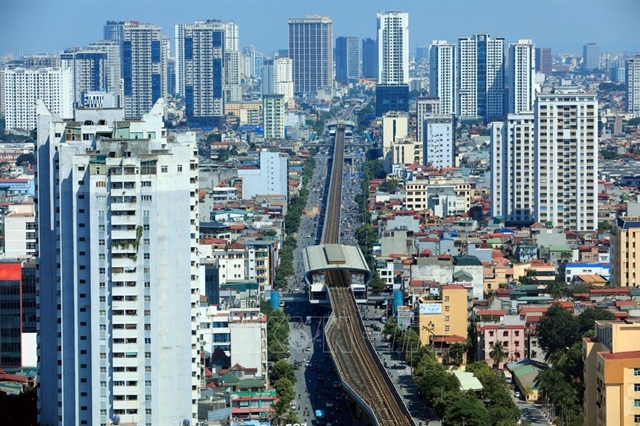 Business Beat
Business Beat

Faced with the likelihood of inflation, banks have to increase their deposit interest rates to ensure positive real interest rates to prevent depositors from withdrawing their money and investing it in other assets like securities and real estate.
BUSINESS BEAT

|
| A customer makes transaction at Sacombank which was one of the first to hike the deposit interest rates, increasing them by 0.4 percentage points on average in early November. — Photo bnews.vn |
Compiled by Thiên Lý
In October, the average interest rates on bank deposits for six months and 12 months were 4.7 per cent and 5.5 per cent, down half a percentage point from a year earlier, according to Bảo Việt Securities Company.
But things changed in early November when the rates showed signs of rising after a very long time.
Deputy Governor of the State Bank of Việt Nam, Đào Minh Tú, said in 2021 the rates were at the lowest level in five years.
Sacombank was one of the first to hike the rates, increasing them by 0.4 percentage points on average.
Eximbank adjusted them upward by 0.1 percentage point for three months or less and 0.2 percentage points for six to nine months.
The highest rates of 7 per cent are offered by some large banks like ACB, Techcombank and MSB for high-value long-term deposits.
The rising trend is expected to continue.
Many analysts had forecast the rates would increase further at last year-end and this year.
So what caused this change?
Now many are pointing to the looming spectre of inflation, always a major factor in driving up all sorts of interest rates.
For more than a year, deposit rates were just 5-5.5 per cent on average, and investors were not unhappy since inflation was below 3 per cent.
In fact, in the first 10 months of 2021 the consumer price index only rose by 1.8 per cent year-on-year, the lowest rate since 2016.
According to the General Statistics Office, core inflation during the period was 0.84 per cent compared to the same period in 2020.
The agency said core inflation rate had been the lowest since 2011.
Core inflation is the indicator reflecting long-term general price changes, after excluding temporary changes of the Consumer Price Index (CPI).
Thus, people could still be induced to deposit their money in banks.
But now many economists expect inflation to rise as the prices of many commodities and goods have started to increase.
A GSO official said the costs of raw materials used in many industries have risen sharply, especially in October, pushing up prices, including of essential consumer goods.
Besides, the rise in fuel prices has an effect on the prices of all kinds of goods, he pointed out.
The prices of petrol and other fuels were adjusted upward 18 times last year, resulting in A95 petrol going up by VNĐ7,860 per litre and E5 petrol by VNĐ7,600 by October.
Gas products saw their prices hiked eight times.
Consequently, the prices of a number of key raw materials have surged, including plastics by12.9 per cent and textile fibres by 10.78 per cent, according to a GSO report.
Experts calculate that every 1 percentage point increase in raw material prices translate into a 2.06 per cent increase in product prices.
Inflation is expected to rise to 3.5-4 per cent in 2022.
Money supply
Bùi Thuý Hằng, deputy director of the central bank’s monetary policy department, said as of November 25 the total outstanding loans at banks were up by 10.1 per cent.
With the Government injecting around VNĐ672.01 billion to help revive business activities, large sums of money have been pumped into the economy, significantly increasing money supply and thus inflationary risks.
Deputy Minister of Industry and Trade Đỗ Thắng Hải told a government meeting in December that inflationary pressure would be high in 2022, especially with both the global and Vietnamese economies expected to experience a strong bounce back as herd immunity is achieved.
Faced with the likelihood of inflation, banks have to increase their deposit interest rates to ensure positive real interest rates to prevent depositors from withdrawing their money and investing it in other assets like securities and real estate.
Hải said by doing this lenders, specially small ones with modest liquidity, would ensure they have enough funds to continue lending.
Analysts also pointed to other reasons for the increase in deposit interest rates.
With COVID-19 vaccination covering almost the entire adult population, hope is rising that the pandemic would soon be controlled and economic activities would return to normalcy, increasing demand for credit.
Anticipating this, banks have started increasing their deposit interest rates to mobilise more funds to meet future market demand when the cost of money is still low and before competition drives it up.
But banking sector insiders expect deposit interest rates to only see slight changes.
Time will tell.
Far-sighted seafood producers buck COVID downturn
Early this year, most of the forecasts for the seafood industry were optimistic since the COVID pandemic was well controlled in Việt Nam, enabling the country to grab global market shares from other seafood exporting countries, many of which were badly affected by the outbreak.
But things changed since the fourth wave of the pandemic hit the country: most sectors were hit badly and seafood was no exception.
In the third quarter of 2021, tra fish (catfish) exports dried up as COVID raged in several provinces in the south, the key seafood exporting region.
Many companies had to halt production while a few operated at just 30-50 per cent of their capacity.
Consequently, exports of the catfish, one of the country’s biggest earners, declined by 25 per cent year-on-year.
Things were not worse only because some businesses managed to do well thanks to stocking up on raw materials before the outbreak began.
Though Việt Nam is a power house of agriculture, especially fisheries, only those companies that prepared well by ensuring adequate availability of raw materials and markets have been able to beat the pandemic’s effects.
Vĩnh Hoàn Corporation was one of them. It saw turnover and profit increase by 25 per cent and 33 per cent year-on-year in the first nine months of 2021 to VNĐ 2.3 trillion and VNĐ233 billion, respectively.
A spokesperson said exports were not affected much since the company had stockpiled a huge volume of raw materials like catfish fillet while supply sources both at home and abroad were broken amid the pandemic.
Besides, its main export markets are the US and China, whose demand for seafood products remained steady despite the outbreak, he added. — VNS




